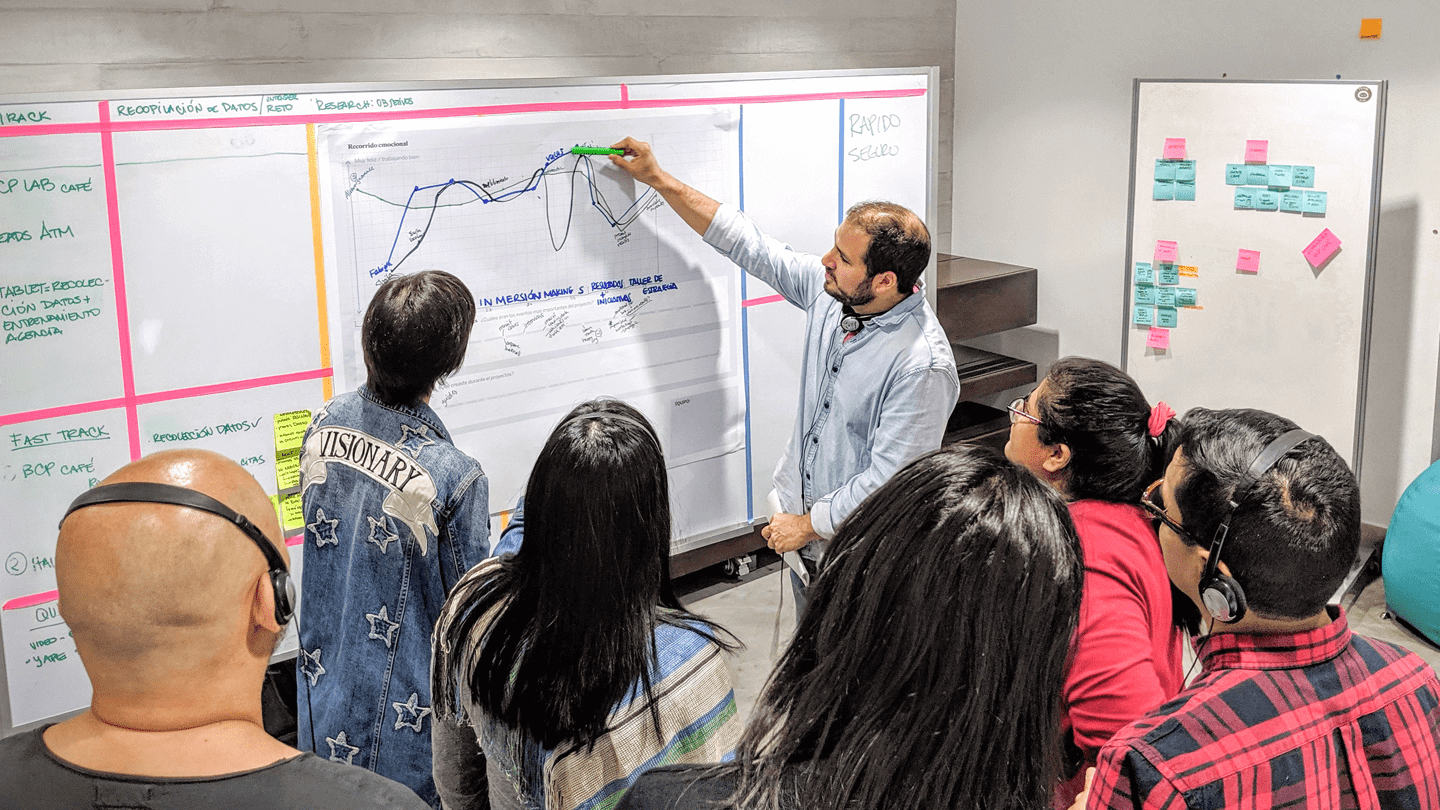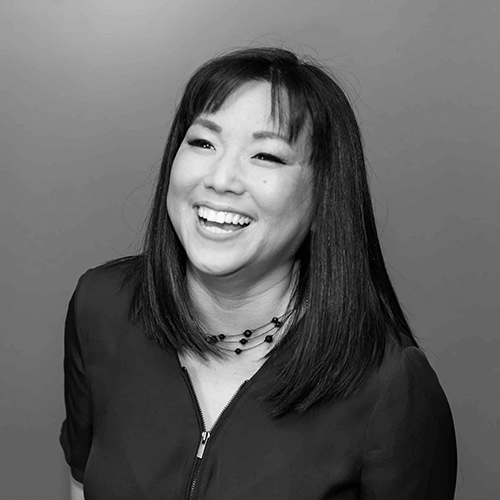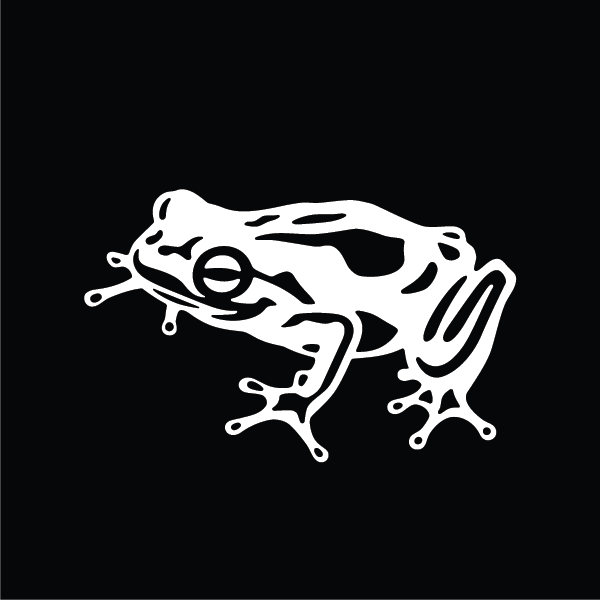Mariela Sotomayor is Head of Strategic Design at BCP. At the bank she focuses on leading the design team and guiding projects through the perspective of human centered design. With an Industrial design background, Mariela brings more than 12 years of experience in product and service design and has worked with social organizations and in different industries tackling challenges related to education, public services, financial services and healthcare.

Dialing up Design in a Large Enterprise
So you’ve stood up a design function in your organization. Good! Now what?
This is the exact question that Banco de Crédito del Perú (BCP) was asking itself when it reached out to frog. BCP is Peru’s largest bank in a country with tremendous opportunity to reach some of the most significant un- and under-banked populations. As a part of a massive transformation, BCP had ambitious aspirations to claim the best customer experience in all of Peru—not just among banks, but all Peruvian brands.
When frog first visited BCP, we were impressed by all the progress that had already been made. After embarking on a world tour of customer-centric organizations, the executive committee had adopted an agile tribe model, standing up agile as a new way of working, and transformed the corporate campus into a vibrant and inviting creative environment covered in bright Post-it Notes and whiteboard sketches. We even found people playing musical instruments in corners of team spaces. As designers, we felt right at home.
When you incorporate the client earlier, the client becomes part of your team. Putting the clients at the center is part of the design job.




In just three years, BCP had grown a design team from 4 people to nearly 60 UX, UI, and design researchers. They had adopted new cultural principles including “Customer Centric: Our clients are at the center of all our decisions.” The battle to get a seat for design in the organization had been won, but how does the enterprise sustain and scale the design function? The question they posed to frog was, “how are we doing, and where do we go from here?”
BCP’s head of design, Mariela Sotomayor, and frog embarked on an intensive six-week program to answer these questions, starting from the shared premise that driving business impact requires much more than excellent design craft. The correct approach, environment, talent and passion is needed, along with a strong mind-shift from technology and business partners to truly embrace and appreciate design within the company.
Methodological approach
The main inputs gathered to support the assessment included surveys on existing design capabilities, at both individual and organizational levels, and project debrief sessions with teams. We also conducted a high number of formal and informal interviews with BCP and design leaders, design team members and other key business roles.
Surveys
A cross-functional organizational survey was deployed across leadership, design and key functions to evaluate how the design vision was being supported in execution by the talent, processes, structure and enabling tools/technology.
In addition, an individual design skills survey was deployed within the design team in a 360º format, with the aim of gathering not only the self-assessment from designers on their own capabilities, but also the perspectives from their managers, peers, direct reports, business partners and frog team. These skills were built upon the “Design Skills Coin” (Moneda) that frog created specifically for BCP.
Project debrief sessions
Twelve in-depth project debriefs took place. In order to maximize the effectiveness of the sessions, teams prepared homework that included a project scorecard and emotional journey map. Through the two-hour sessions, we understood what was done, why and how, as well as the impact. We also had the opportunity to better understand the designers’ skills and identify some of their main opportunity areas.
On-site visit and stakeholders interviews
Both during the executive visit by key leaders to the frog NY studio, and during the frog stays in Lima, we had the opportunity to really get to know the BCP and design leaders, the design team members, and other key business partners. Through individual and group interviews, as well as more informal conversations, we achieved a deep understanding of their perspectives as well as the strategic and cultural transformation context of BCP.

Outcomes
In total, frog synthesized over 50 hours of intake, resulting in a set of impactful outcomes. At the individual level, frog provided each of the 52 designers with an individual scorecard including the results of their 360º assessment and their main strengths and opportunity areas according to the comments of their evaluators. Additionally, designers received a development guide devoted to helping them create a specific action plan to develop and grow their design capabilities according to the results obtained.
At the organizational level, frog delivered the design organization assessment and the resulting high-level observations or opportunity areas for the design area, as well as a set of 6 actionable recommendations and 60 tactics framed in a prioritized two-year roadmap for implementation

The resulting roadmap is informing key areas of investment and growth for BCP as they continue to grow on their journey to excellence. BCP is creating a path for designers within their enterprise, adding strategic value to the business through close partnerships, and influencing the overall strategy of leadership as it learns more about customers’ needs through design.
Were no longer competing with banks. Were competing with Amazon, Apple, Google... Customer experience is what is going to really differentiate us in the future.
Understanding the value of design for your organization is the first important step in what should be an ongoing conversation and assessment relying on cross-functional learning across design, business and technology. Design can push organizations to grow, to adapt and to innovate, but the organization itself must be part of that journey. Only if the whole organization truly understands and involves design in the early stages of the decision-making process is it possible to elevate design to the strategic level and, consequently, drive customer-centricity across the organization.

Linda provides a broad range of consultative services to build capability and improve organizational performance with clients globally. After more than two decades leading organization transformations from within, Linda brings empathy for leaders driving culture change, innovation and growth in organizations from startups to Fortune 500.


Nieves Padilla is a Senior Strategist at frog Madrid. Combining an innovative mindset and a practical approach to make data-driven decisions, she is able to conceptualize complex business challenges in order to drive change in organizations. She brings more than 8 years of experience in strategy consulting engagements involving customer experience transformation, organizational transformation and corporate and portfolio strategy for worldwide companies within industries such as financial services, transport, services or tourism & entertainment.
We respect your privacy
We use Cookies to improve your experience on our website. They help us to improve site performance, present you relevant advertising and enable you to share content in social media. You may accept all Cookies, or choose to manage them individually. You can change your settings at any time by clicking Cookie Settings available in the footer of every page. For more information related to the Cookies, please visit our Cookie Policy.